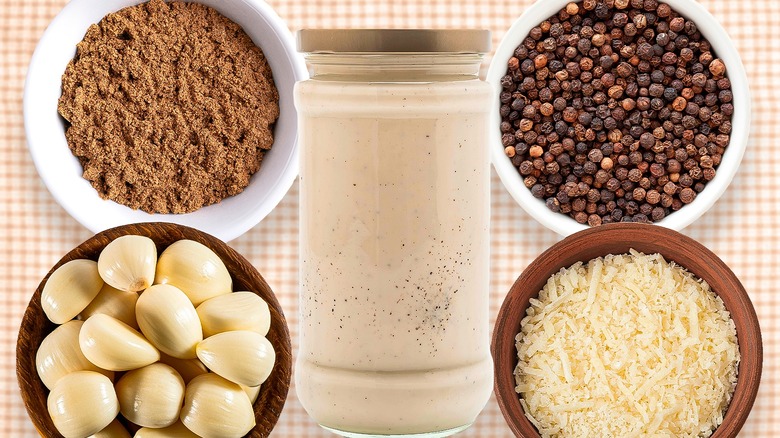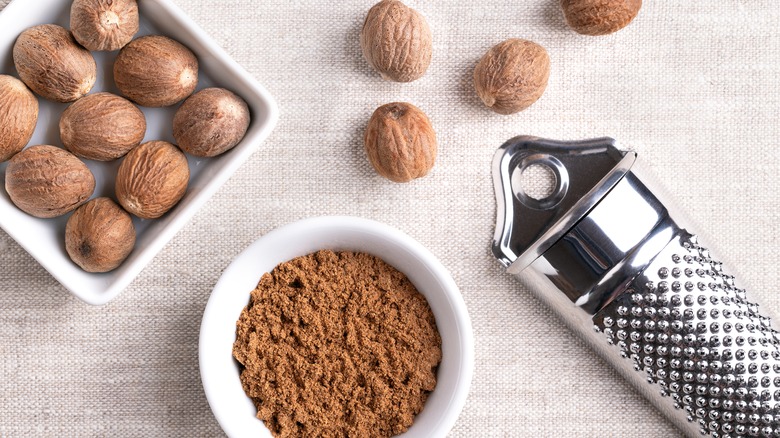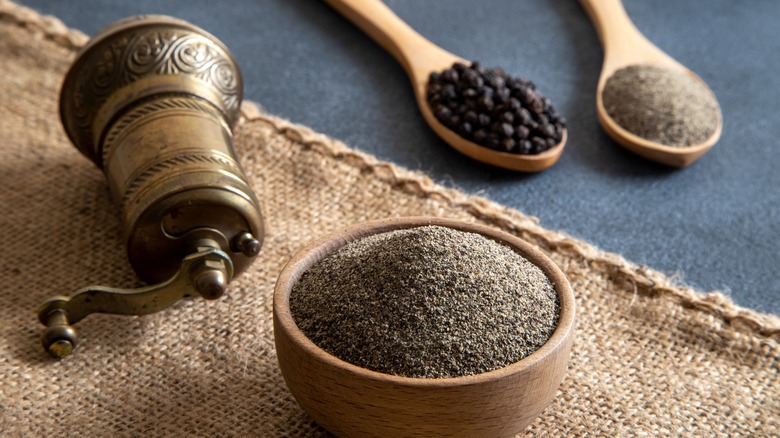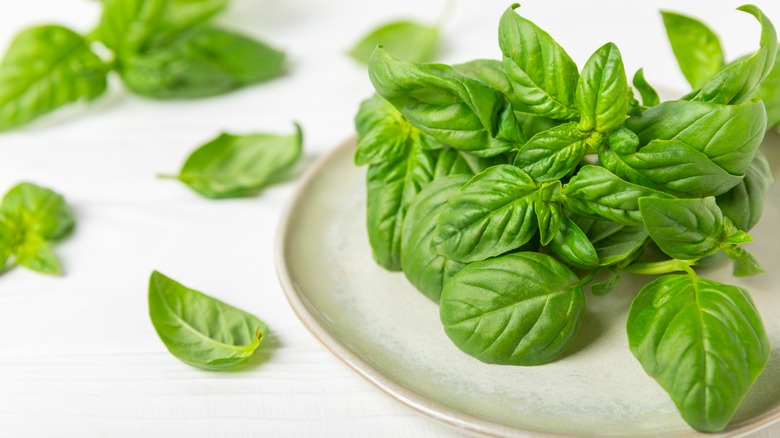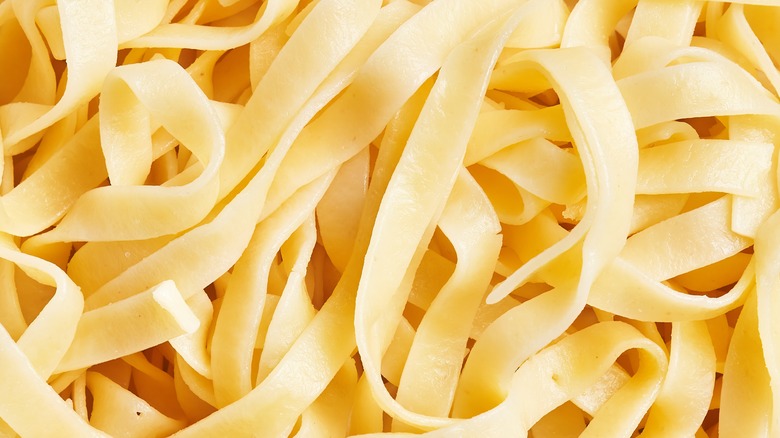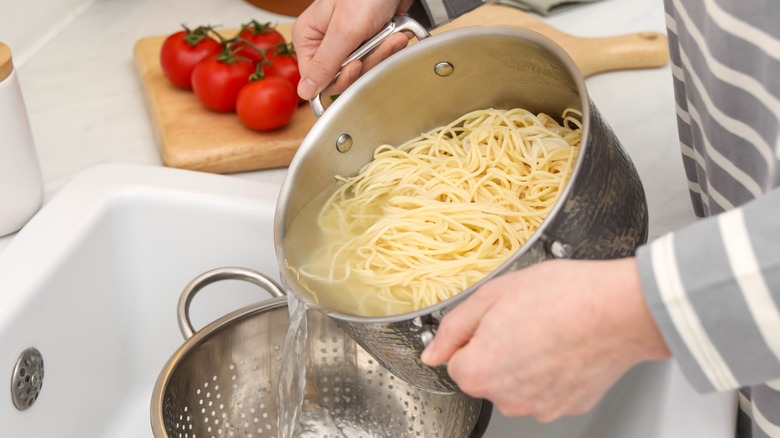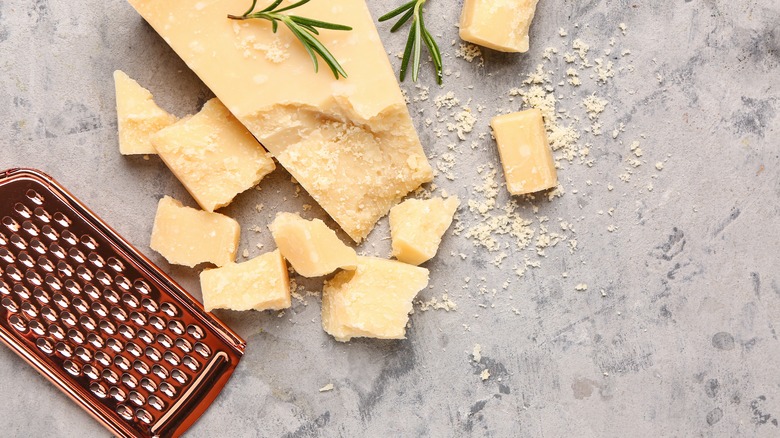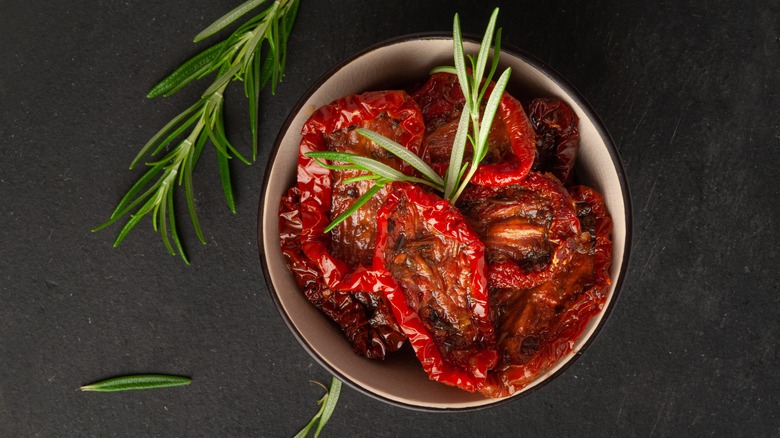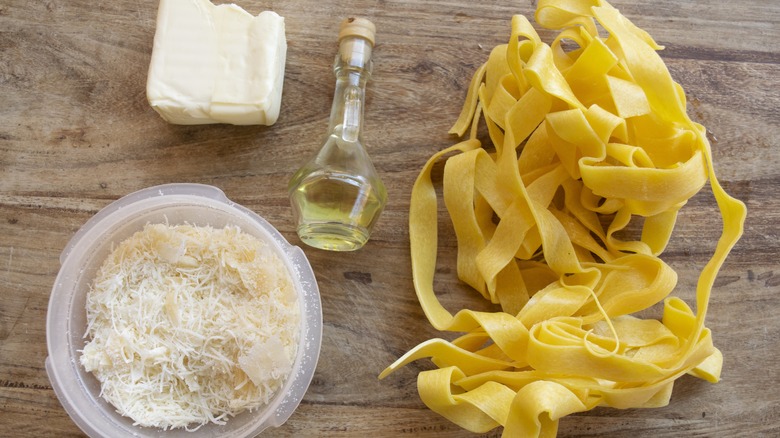11 Ways To Make Store-Bought Alfredo Sauce Taste Homemade
In a perfect world, we would all have plenty of time to cook fresh, homemade meals every day using top-quality ingredients — including the delicious Italian classic, pasta Alfredo. In reality, though, there sometimes just aren't enough seconds in the day, and the convenience of picking up a store-bought pasta sauce can be a game changer.
However, with some store-bought Alfredo sauces, something is simply lacking, and these products don't have the authenticity of a fresh sauce. This is where your creativity can kick in. By adding a few choice ingredients, you can end up with a sauce that tastes close to a homemade version, without having to start from scratch.
To help you make the most of your store-bought Alfredo sauce, I spoke to a pair of experts who shared their knowledge of Italian cuisine. Donna Poirier is the food blogger and recipe creator behind LadyPearTree, and Liz Krause is the founder of Simple Italian Cooking. Between the two of them, these culinary pros have plenty of insight on how to improve store-bought Alfredo sauce and help make it taste homemade. From choosing the correct cheese to making sure the pasta is the right type, these crucial tips will keep you on the right track. So, grab your spaghetti spoon — sorry, fettuccine spoon — and let's explore the best ways to improve store-bought Alfredo sauce.
Add nutmeg to the sauce
A great way to make store-bought Alfredo sauce taste homemade is to add the subtleties of flavor that are found in fresh versions of the sauce. One example is nutmeg, a spice that is often used in Alfredo recipes — though sparingly — to give an understated lift to the sauce. It is an ingredient that is also often used in creamy béchamel, and it can have a similar effect for an Alfredo sauce.
"Freshly grated nutmeg can have a big impact," says Donna Poirier. "This warm, slightly sweet spice enhances the creaminess of Alfredo sauce without overwhelming it." If you can, use fresh nutmeg and grate it right before you use it — but you will need a specialized spice grater to make sure the powder is sufficiently fine.
You may wonder if such a small amount of spice can make a difference to the flavor of the sauce, but the delicate touch it adds makes the difference between an authentic Italian Alfredo sauce and a so-so one from a jar. "Add the nutmeg just before serving to keep the flavor alive," advises Poirier. "It's a subtle touch that complements a creamy, cheesy sauce."
Use Pecorino cheese in store-bought Alfredo sauce
Of course, a delicious Alfredo sauce will need some high-quality cheese, and although Parmesan may be your first thought, there is another classic Italian cheese that is recommended as well. "While Parmesan is a common addition to Alfredo, Pecorino Romano offers a sharper, saltier flavor that pairs beautifully with the creamy sauce," suggests Donna Poirier. The lesser-known Pecorino is a hard Italian cheese that is named after the breed of sheep that provides the milk that it's made with. It tastes delicious on its own, but it's often grated into sauces to add a complex umami flavor, similarly to Parmesan.
"Parmigiano is a great cheese for Alfredo, but for a more robust flavor I would recommend a combination of Parmigiano Reggiano and Pecorino Romano — or just Romano," advises Liz Krause. "I cook primarily with Romano cheese in general. Parmigiano has a milder flavor, so you can use more of it to make the sauce creamy without having too strong a cheese flavor. I personally love Romano and feel it brings the sauce to life." Remember that both Pecorino and Parmesan are pretty salty, so don't add any salt until after you have added the cheese. With the complex flavor Pecorino brings, you may not need any additional salt at all.
One aspect often missing from a store-bought Alfredo sauce is high-caliber cheese, so try to get the best-quality products that you can, whether you are using Pecorino, Parmesan, or both. A small amount of high-quality cheese will elevate your sauce much more effectively than a generous helping of subpar cheese.
Season the sauce with black pepper
When it comes to seasoning Italian dishes, black pepper is a crucial element to achieve authentic flavor. There may already be black pepper in your store-bought Alfredo sauce, but nothing beats the taste of freshly ground peppercorns.
The seasoning benefits of black pepper don't stop at its bold taste — it actually improves the way we perceive other flavors as well. However, this seasoning superpower is only possible with freshly ground pepper, meaning that having a pepper mill in your kitchen is essential.
Liz Krause makes clear that the first seasoning she'll reach for to improve store-bought Alfredo sauce "would be black or white pepper." If you're using Pecorino cheese, black pepper will combine with it to impart the classic flavors of another classic Italian pasta dish — cacio e pepe. This traditional Roman specialty features Pecorino and black pepper as its main two flavorings, so it's safe to say they are a perfect combination. Donna Poirier certainly thinks so, suggesting the combination of Pecorino "with freshly cracked black pepper for a finishing touch that adds warmth to your sauce."
Infuse store-bought Alfredo sauce with fresh basil
Adding fresh herbs to your store-bought Alfredo sauce allows you to include an element that is simply impossible to bottle. The aromatic compounds in fresh herbs evaporate easily, meaning that they are lost either by cooking or exposure to the air. Even if fresh herbs have been added to the jar, their delicious, fragrant notes will be diminished by the time the sauce reaches your plate.
Basil is the quintessential Italian herb, and its sweet flavor featuring a hint of aniseed is used to brighten many authentic dishes of Italy. Donna Poirier suggests adding basil to store-bought Alfredo sauce as you heat it, to allow the herb to infuse without destroying the oils. "Add a handful of fresh basil leaves to the sauce as it simmers for an aromatic twist," she recommends. "The heat gently releases the herb's natural oils, infusing the rich Alfredo sauce with the brightness of fresh herbs."
However, restraint is key, as Liz Krause warns about the effect of adding too many strong flavors into the mix. "Adding herbs will make a huge difference, so be careful," she advises.
Choose fresh fettuccine
Many Italian restaurants in the U.S. allow you to mix and match whatever pasta shape you wish with your preferred sauce, so you may not be aware that Italians are very particular about this issue. While spaghetti Bolognese may be a classic pasta dish to us, an Italian nonna would scowl at the suggestion, insisting that classic ragu alla Bolognese should only be served on tagliatelle. For similar reasons, when it comes to Alfredo sauce, fettuccine is the pasta of choice. The wide ribbons are more suited than spaghetti to holding onto the sauce, meaning it won't slip off the pasta as it journeys from bowl to mouth.
"When it comes to Alfredo, the pasta you use matters," confirms Donna Poirier. "Fresh fettuccine, as opposed to dry, is ideal because its rough texture allows the creamy sauce to cling to the noodles better. The result is a more balanced dish where every bite is coated in sauce."
Of course, this is simply the optimal combination, and if you already have a variety of pasta shapes in your pantry, it's not strictly necessary to rush out and purchase another. "If fresh fettuccine isn't available, other long pasta shapes like spaghetti, linguini, or tagliatelle will work in a pinch," admits Poirier, with a caveat. "Avoid delicate pasta like capellini or vermicelli, because they are too delicate for this rich sauce."
Loosen store-bought Alfredo sauce with pasta water
One of the main complaints about jars of pasta sauce is that they don't quite have the right consistency. "Many store-bought Alfredo sauces can be thick due to ingredients like modified cornstarch and guar gum," explains Donna Poirier.
The key to solving this problem is surprisingly simple, and you don't even need any extra ingredients. As the fettuccine boils, some of the starch from the pasta will make its way into the boiling water, which would usually be poured away. "Reserve some starchy water from cooking your pasta to achieve the perfect consistency," says Poirier. "Gradually add a few tablespoons to the Alfredo sauce until it reaches a looser, more velvety texture. This makes the sauce easier to toss with your pasta."
However, be sure to add the water in very small amounts. Otherwise, you may end up making the sauce too watery, and then will need to try thickening it up again!
Add garlic, but not too much
One surefire way to add flavor to a dish is with a touch of garlic, and Italian food is well-known for utilizing the pungent taste of this allium. But show restraint if adding garlic to your store-bought Alfredo sauce, since there is a fine line between enhancing the sauce and overpowering its other ingredients.
"Garlic will boost the savoriness of any dish, and Alfredo sauce is no exception," Donna Poirier points out. "For added flavor, sauté minced garlic in butter before adding the store-bought sauce, or mix in some roasted garlic for a mellow, caramelized sweetness. Either option will give your Alfredo a more robust flavor."
If you are worried about the effect that fresh garlic will have on the balance of the sauce, you can always add garlic powder instead; this is something that Liz Krause recommends. "If you want to control the potency of garlic, avoid any brand that includes garlic in the ingredients. Instead, add your own dash of garlic powder — a little at a time, until you have the taste you want," she suggests. "I have done this in the past with various store-bought sauces, where I find a good basic sauce and then modify by adding my own seasonings." Krause adds that if you accidentally add too much garlic powder, or any other seasoning, extra cream or milk can be poured in to dilute the sauce.
Grate fresh Parmesan over the top
Even if you are using Pecorino Romano as the main cheese in your sauce, it is still essential to include Parmesan if you want your Alfredo to taste as authentic as possible. The key to finishing off your store-bought Alfredo with an authentic Italian touch is to add high-quality Parmesan before serving, and it must be fresh. Dried Parmesan that you find on the unrefrigerated shelves at the grocery store tastes nothing like the real thing and should be avoided if you want true Italian flavor.
"While pre-grated Parmesan might be convenient, investing in real Parmigiano Reggiano from Italy is essential for Alfredo sauce," insists Donna Poirier. "This authentic cheese has a nuttier, more complex flavor that stands out in a creamy sauce. Grate it fresh over your finished dish for a homemade feel."
Buying aged Parmigiano Reggiano may not be cheap, but it will take your store-bought Alfredo sauce — and other Italian dishes — to mouthwatering new heights, and the strength of its flavor means that you don't need too much at a time. So, ditch the dried version and buy a small wedge of high-quality cheese to see you through a few weeks of cooking.
Add a splash of color with sun-dried tomatoes
Tomatoes are a classic ingredient of Italian cuisine, and although they may not feature in a traditional Alfredo sauce, adding a few to your store-bought version can help to brighten the flavor with a delicious burst of acidity. To provide your dish with color and extra flavor, "add chopped sun-dried tomatoes to your Alfredo sauce," suggests Donna Poirier. "The tomatoes' sweetness and tanginess perfectly balance the cream's richness." By using sun-dried tomatoes instead of fresh tomatoes, you can enjoy the concentrated flavor of this addition without affecting the texture of the sauce.
Adding sun-dried tomatoes to your Alfredo also adds a boost of nutrition to a sauce that — unusually for a Mediterranean dish — is essentially devoid of vegetables. Sun-dried tomatoes actually provide the body with more lycopene than their fresh counterparts. Lycopene is a potent antioxidant that is thought to reduce the risk of certain cancers, so adding a few sun-dried tomatoes to your sauce may benefit more than just your taste buds.
Adjust the creaminess by adding whole milk or heavy cream
There is no denying that fettuccine Alfredo is a creamy dish, and store-bought versions of the sauce can sometimes be lacking in the richness department. A few well-chosen dairy products will allow you to tweak its texture, and make it taste more like a homemade version.
"You can add more cream or milk to store-bought sauces," says Liz Krause, while noting that she prefers making Alfredo sauce with whole milk, butter, and cheese rather than cream, out of health considerations. For another liquid addition that can improve both the flavor and texture, Krause recommends "a drop of some chicken broth."
If going the dairy route, the amount of cream or milk you choose to add will depend on how decadent you want the dish to be, and how much you are concerned about the sauce being heavy. "The more fat that's used, the creamier the sauce will be," confirms Krause. "The trick is finding a balance so that it doesn't become too thick, where it's like a heavy gravy, and not too thin, where it's super runny."
Pick store-bought Alfredo sauce with minimal ingredients
When upgrading a store-bought sauce, the temptation is to throw as many ingredients at it as possible, in an attempt to recreate the authentic flavor of a homemade version. However, the nature of store-bought sauces — particularly jarred varieties — means that they already contain many more ingredients than a homemade sauce would, to keep them shelf-stable. Liz Krause believes that the key to making store-bought Alfredo sauce taste better is to choose a brand made with the fewest ingredients to begin with.
"Store bought Alfredos typically have too many ingredients," Krause explains. "For a basic Alfredo, it's important to use cream, whole milk, and butter or buttermilk. Some companies will use skim milk, but use some form of starch to help thicken it."
Generally speaking, the simplest sauces will be available in a supermarket's refrigerated section, rather than on the shelves with jarred and canned goods. This means they are likely more expensive and will have a much shorter shelf life. Check the list of ingredients on the back, and try to avoid any brands packed with additions you can't pronounce — unless they are Italian food names, of course! "Also try to avoid brands that include water as the first ingredient," advises Krause. "Instead, look for where cream or milk is listed as the primary ingredient."
